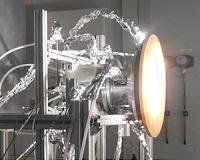 |
Reno NV (SPX) Feb 07, 2011 A team of University of Nevada, Reno and University of Nevada, Las Vegas researchers have devised a new model for how Nevada's gold deposits formed, which may help in exploration efforts for new gold deposits. The deposits, known as Carlin-type gold deposits, are characterized by extremely fine-grained nanometer-sized particles of gold adhered to pyrite over large areas that can extend to great depths. More gold has been mined from Carlin-type deposits in Nevada in the last 50 years - more than $200 billion worth at today's gold prices - than was ever mined from during the California gold rush of the 1800s. This current Nevada gold boom started in 1961 with the discovery of the Carlin gold mine, near the town of Carlin, at a spot where the early westward-moving prospectors missed the gold because it was too fine-grained to be readily seen. Since the 1960s, geologists have found clusters of these "Carlin-type" deposits throughout northern Nevada. They constitute, after South Africa, the second largest concentration of gold on Earth. Despite their importance, geologists have argued for decades about how they formed. "Carlin-type deposits are unique to Nevada in that they represent a perfect storm of Nevada's ideal geology - a tectonic trigger and magmatic processes, resulting in extremely efficient transport and deposition of gold," said John Muntean, a research economic geologist with the Nevada Bureau of Mines and Geology at the University of Nevada, Reno and previously an industry geologist who explored for gold in Nevada for many years. "Understanding how these deposits formed is important because most of the deposits that cropped out at the surface have likely been found. Exploration is increasingly targeting deeper deposits. Such risky deep exploration requires expensive drilling. "Our model for the formation of Carlin-type deposits may not directly result in new discoveries, but models for gold deposit formation play an important role in how companies explore by mitigating risk. Knowing how certain types of gold deposits form allows one to be more predictive by evaluating whether ore-forming processes operated in the right geologic settings. This could lead to identification of potential new areas of discovery." Muntean collaborated with researchers from the University of Nevada, Las Vegas: Jean Cline, a facultyprofessor of geology at UNLV and a leading authority on Carlin-type gold deposits; Adam Simon, an assistant professor of geoscience who provided new experimental data and his expertise on the interplay between magmas and ore deposits; and Tony Longo, a post-doctoral fellow who carried out detailed microanalyses of the ore minerals. The team combined decades of previous studies by research and industry geologists with new data of their own to reach their conclusions, which were written about in the Jan. 23 early online issue of Nature Geoscience magazine and will appear in the February printed edition. The team relates formation of the gold deposits to a change in plate tectonics and a major magma event about 40 million years ago. It is the most complete explanation for Carlin-type gold deposits to date. "Our model won't be the final word on Carlin-type deposits," Muntean said. "We hope it spurs new research in Nevada, especially by people who may not necessarily be ore deposit geologists."
Share This Article With Planet Earth
Related Links University of Nevada Powering The World in the 21st Century at Energy-Daily.com
 New Reactor Paves The Way For Efficiently Producing Fuel From Sunlight
New Reactor Paves The Way For Efficiently Producing Fuel From SunlightPasadena CA (SPX) Jan 21, 2011 Using a common metal most famously found in self-cleaning ovens, Sossina Haile hopes to change our energy future. The metal is cerium oxide-or ceria-and it is the centerpiece of a promising new technology developed by Haile and her colleagues that concentrates solar energy and uses it to efficiently convert carbon dioxide and water into fuels. Solar energy has long been touted as the solut ... read more |
|
| The content herein, unless otherwise known to be public domain, are Copyright 1995-2010 - SpaceDaily. AFP and UPI Wire Stories are copyright Agence France-Presse and United Press International. ESA Portal Reports are copyright European Space Agency. All NASA sourced material is public domain. Additional copyrights may apply in whole or part to other bona fide parties. Advertising does not imply endorsement,agreement or approval of any opinions, statements or information provided by SpaceDaily on any Web page published or hosted by SpaceDaily. Privacy Statement |